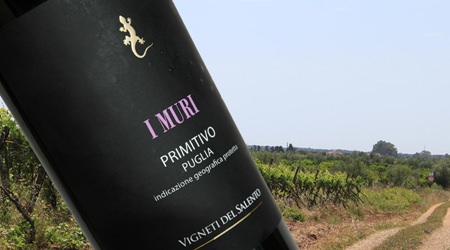Ask any American to name their country’s most well-known wine and the chances are they’ll tell you it’s Zinfandel, known affectionately as “Zin”. Mention the name Zinfandel to the average wine-drinker in Great Britain and it is more likely that you’ll receive a blank stare of incomprehension, for the wine is not often seen there. In case you didn’t know, Zinfandel is a dark-skinned red wine grape variety that has found its present home in California where it accounts for ten percent of the plantings. Red Zinfandel has become North America’s signature wine.
The grapes first appeared in New York in the early years of the 19th century, possibly and indirectly from the Imperial Nursery in Vienna. George Gibbs, a horticulturist on Long Island received various grapevines from Vienna and elsewhere in Europe during the 1820s. Among them was Zinfandel, also known for some reason as Black St. Peters. Many vines were taken to California in the days of the Gold Rush and by the end of the 19th century Zinfandel had been planted throughout the state.
 Background: Vineyards near Castellaneta, Puglia. (Photo: drdcuddy)
Background: Vineyards near Castellaneta, Puglia. (Photo: drdcuddy)
During the twentieth century few Americans realised that Zin actually came from somewhere else, although as early as the 1960s suspicions were being aroused among professionals in the wine trade. Even so, in 1974 the American writer Harold Grossman described Zinfandel as “a California original, grown nowhere else” and in the 1980s, the distinguished British writer Hugh Johnson described it as “California’s own red grape”. Most people agreed with them. It was not until 1993, after years of research and argument that a DNA fingerprinting technique at the University of California finally confirmed that Zinfandel is identical to Italy’s Primitivo.
But the story wasn’t over. Primitivo originally arrived in Italy from Croatia where it was known by various names including the somewhat unhelpful name of Crljenak Kaštelanski. The search for Zinfandel’s origins was finally published in 2012 and there is now firm evidence that the original Zin was the Croatian grape known as Tribidrag which dates back at least until the 15th century. I have abridged the tale considerably, but that’s the gist of it.
Primitivo is used extensively in wines from Puglia in southern Italy. If you recall the boot-like shape of the country, Puglia is the bit down at the back of the heel. It’s tempting to think that the name Primitivo has something to do with “primitive” but actually the word translates roughly as “the early one” presumably referring to its early ripening qualities. In Italy today, most Primitivo is a rustic, highly alcoholic wine.
I Muri Primitivio, Puglia IGP 2012 (red), Italy (Bt. 605 @ Friendship)
This wine is anything but rustic. Produced by expert wine-maker Filippo Baccalaro, it’s is a deep, inky red colour with violet reflections and there’s a rich, complex and intensely fruity aroma. It often seems to me that in high quality wines, aromas appear in a three-dimensional sort of way. Primary aromas show up first and then later, secondary aromas emerge in the middle distance. Last of all come background aromas which are sometimes very shy and reluctant to appear. You really have to search for them. The time it takes for the aromas to appear varies enormously. Some will be obvious in a matter of seconds but others may not reveal themselves until the wine has been opened for twenty or thirty minutes. In contrast, cheap everyday wines and most home-made wines are distinctly one-dimensional and never get beyond the primary aroma.
With this wine, the first aromas are those of ripe red berry fruit. Then the secondary aromas appear – spices and dusty earthy smells followed by a background of dried herbs and the faintest hint of lemon peel. At least, I think it’s the smell of lemon peel. The mouth-feel is a delight: a rich velvety, full-bodied texture but totally dry with soft fruit flavours and caressing tannins that follow through into the long, dry finish. But wait – there’s that faint hint of lemon peel again. This is a splendid wine and it really has something to say. I don’t want to get too theatrical, but this elemental wine seems to speak of the earth. (You’re getting too theatrical – Ed.)
I’d be happy to sit here all evening enjoying this, but the dogs have to be fed. In any case, at 14% alcohol content the wine might be even better with food. Most Italian wines are. I’d guess it would be perfect with a peppery beef steak, if you happen to like that sort of thing.
Sunset Creek Zinfandel 2009 (red), California, USA (Bt. 669 @ Villa)
It may be the same grape variety, but this is a completely different wine. Of course the climate has a lot to do with it, but so do the vineyard conditions, the method of vinification and the intentions of the wine-maker. This Zinfandel is several shades lighter than the Primitivo and it has pronounced orange hints near the rim of the glass, revealing that the wine is no spring chicken. But neither am I, so I can’t complain.
It’s obvious from the first few sniffs that this wine is going to be interesting. There’s a soft, warm and slightly jammy aroma of ripe raspberry and raisin with a dash of dusty cinnamon. It’s very soft on the palate and turned out to be a good deal lighter than I expected. It’s almost totally dry with a delicate touch of acidity but there’s still a good bit of red fruit on the palate which lasts into the lingering finish. I imagine that the tannins were originally quite soft but they have all but faded away.
Most table wines are intended for early consumption and not made to last for more than a few years. This 2009 vintage is now getting on a bit, yet it still has a great deal of charm and elegance. It’s a bit like a slightly frail but aristocratic old duchess. The wine is lovely to enjoy on its own but it would also make an excellent partner for light beef or pork dishes. Although it has 13% alcohol content, the texture is light enough even for chicken. If you want to give it a try, don’t wait too long. Another year and it could well be over the hill. Mind you, so could the rest of us.




